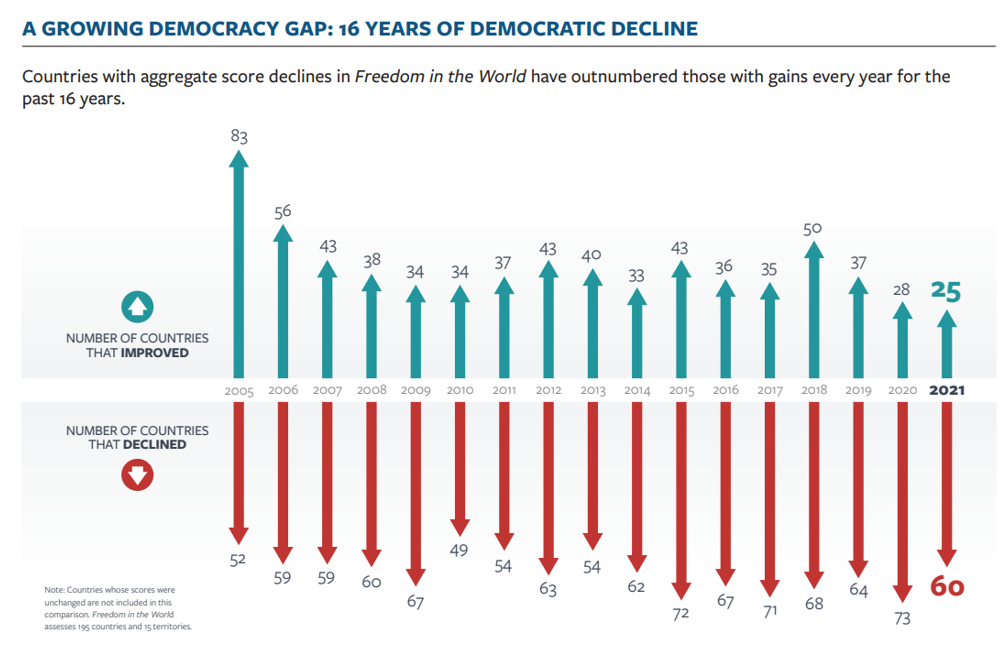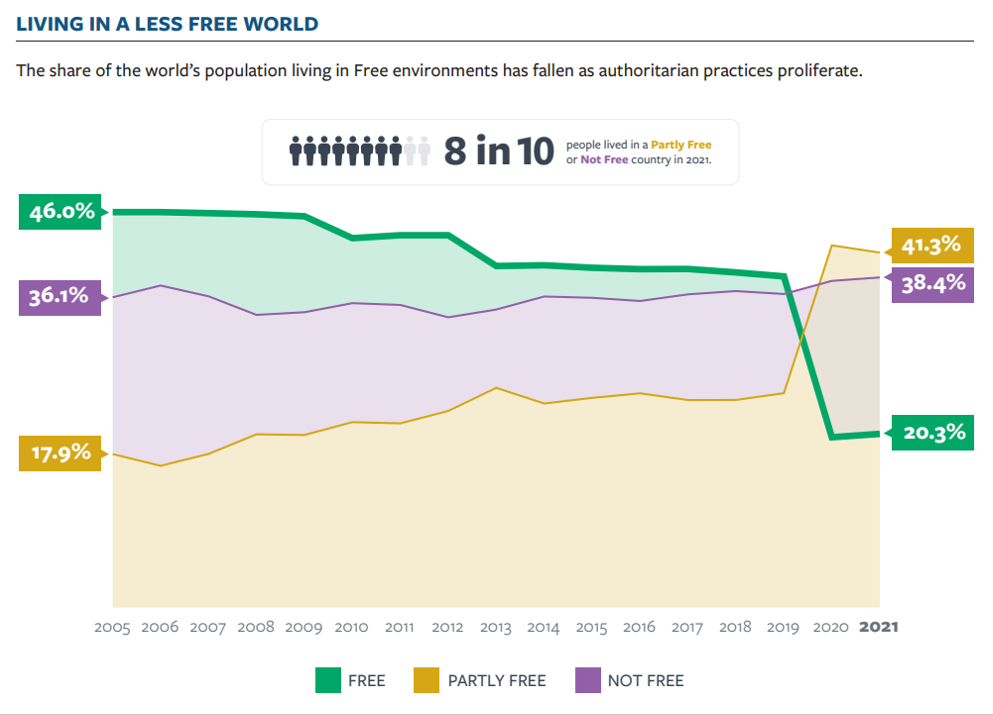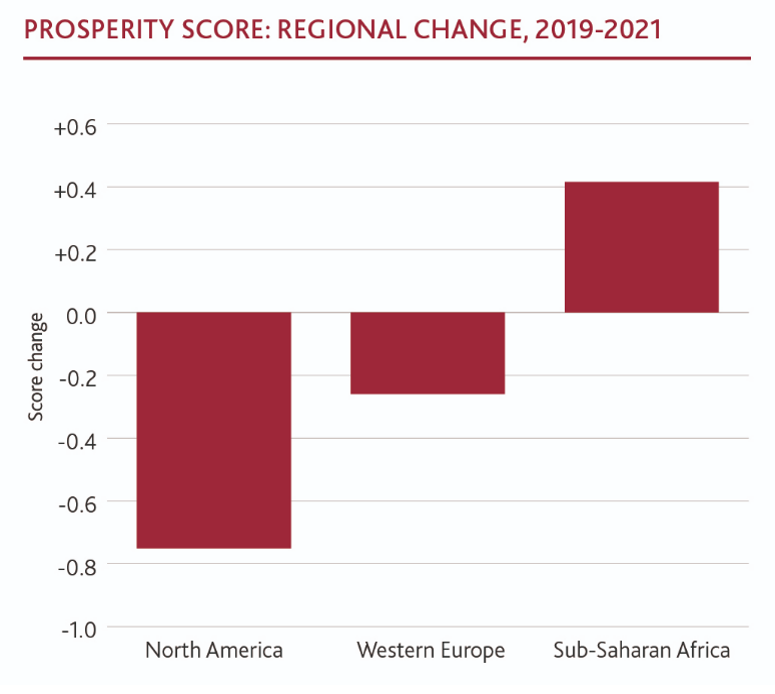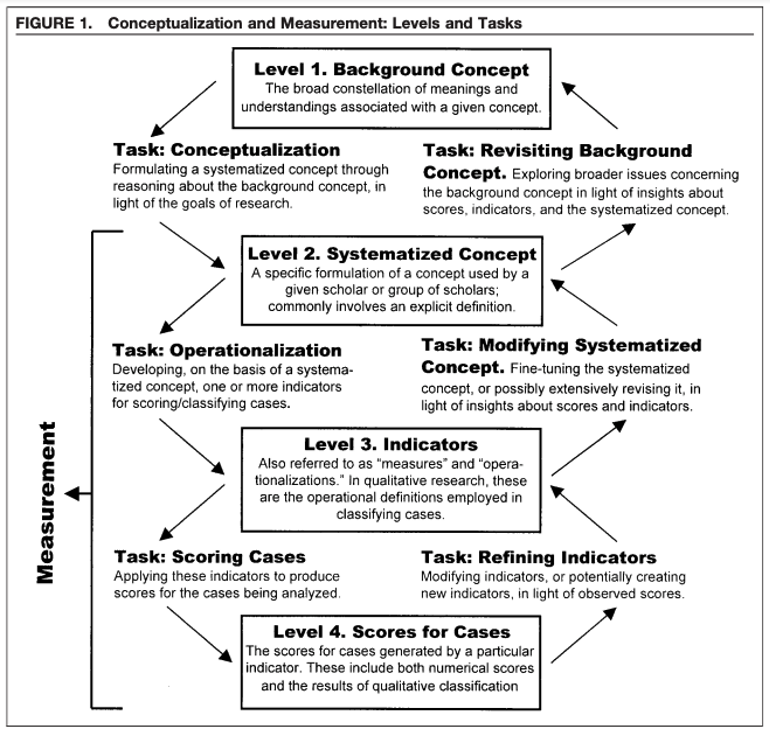|
‘Tis the season for the release of annual democracy, human rights, and governance (DRG) context indicators. Context indicators measure general country or global trends outside of a program’s control. These metrics capture global, regional, and country trends in democracy and governance over time. Policymakers, advocacy groups, and the media rely upon these data sources to frame their positions on key DRG issues. They are important to monitor as they provide information on local needs and dynamics that may affect ongoing USAID programs. In this issue, we summarize lessons from the latest context indicator metrics and annual reports of prominent DRG sector public policy organizations.
This edition of the DRG Learning Digest examines the following topics:
- Despite Citizen Support for Democracy, Authoritarianism Continues to Rise
- Poor Governance Contributes to Economic Decline
- What to Do With These Metrics?
And please make use of DRG Evidence and Learning Team resources! (See text box at the end.)
Despite Citizen Support for Democracy, Authoritarianism Continues to Rise
If 2021 was the year of democracy under threat, 2022 was the year of authoritarian resurgence. After decades of global democratization, 2022 marked 16 straight years of decline in global freedom; Freedom House now categorizes 38 percent of countries as Not Free and just 20 percent as Free (the remaining 42 percent are Partly Free). For the first time since 2004, the Bertelsmann Stiftung’s Transformation Index (BTI) now classifies more states as autocracies than democracies. The Economist Intelligence Unit (EIU) Democracy Index fell from 5.37 in 2021 to 5.28, an even bigger decline than 2020-2021, setting another dismal record for the worst global score since the index was first produced in 2006. According to the Varieties of Democracy Institute (V-Dem), 70 percent of the global population lives in some type of autocratic regime. The Fund for Peace Fragile States Index reveals global erosion of confidence in democratic institutions, in addition to a downward trend in social and political cohesion scores, which render even well-resourced countries vulnerable to vectors of state fragility such as COVID-19, conflict, and violent extremism, as well as the global rise of authoritarianism. “Anybody who thought at the end of 2020 that things could not get worse has been proved wrong,” according to the EIU annual report.
 Sixteen straight years of net decline in global freedom. Source: Freedom House, Freedom in the World 2022: The Global Expansion of Authoritarian Rule.
However, autocratic resurgence is about more than numbers; it is also about the brazenness with which autocrats are behaving. Military and executive coups, disinformation, and even military invasion characterized autocrats’ behavior in 2021 and early 2022. Military coups had been rare in the 21st century, but five military coups resulted in four new closed autocracies – Chad, Guinea, Mali, and Myanmar – and the continuation of Sudan’s autocracy (V-Dem annual report). These coups may signal the emboldening of autocrats, though it is too early to tell if the increase in coups is an aberration or the beginning of a trend. Other countries took steep authoritarian downturns. Nicaragua’s President Daniel Ortega won a tightly orchestrated election after his security forces arrested opposition candidates and deregistered civil society organizations, and Tunisia’s President Kais Saied dismissed parliament and is ruling by decree.
 The percentage of people living in Free countries has declined over the past 16 years. The steep decline in 2019-2020 is due to India moving from the Free to the Partly Free category. Source: Freedom House, Freedom in the World 2022: The Global Expansion of Authoritarian Rule.
Despite rising authoritarianism, citizen support for democracy remains strong. Afrobarometer shows very high support, though many citizens are dissatisfied with the extent of democracy in their countries. In addition, some countries continue to democratize; according to V-Dem, Armenia and Bolivia transitioned from electoral autocracy to electoral democracy in 2021. V-Dem also classifies 15 countries as moving in a democratic direction in the past decade:
- Latin America: Dominican Republic and Ecuador
- Middle East and North Africa: Libya and Tunisia
- Sub-Saharan Africa: Madagascar, Malawi, Seychelles, and The Gambia
- Eastern Europe and Central Asia: Armenia, Georgia, and Uzbekistan
- Asia-Pacific: Fiji, Malaysia, South Korea, and Sri Lanka
Nonetheless, the degree of democratization pales in comparison to the degree of autocratization; the ten best-performers on EIU’s Democracy Index increased a total of 3.5 points, but the ten worst performers decreased a total of 10.21 points. The decline in democracy and democratization has effects beyond elections and governance – V-Dem’s Case for Democracy series shows the myriad benefits of democracy on economic growth, health, education, public services, and other aspects of human well-being.
Poor Governance Contributes to Economic Decline
As the global level of democracy has declined, so too has the quality of governance. BTI noted that the pandemic exposed poor governance in many countries, and “among the 36 states that perform well in [the BTI Governance Index], there are only three autocracies.” The vast majority of those poorly-run governments proved incapable of responding to the political, economic, and social challenges of the pandemic. The World Justice Project reports that almost 85 percent of the world’s population now lives in a country where rule of law is declining. The Legatum Prosperity Index, which measures prosperity as a function of economic strength (e.g., infrastructure and macroeconomic stability), societal inclusion (e.g., civil liberties and social capital), and empowered citizens (e.g., education and health), also reported a decline in global prosperity. The decline in prosperity was due in part to the COVID-19 pandemic, but more concerning was the erosion of political accountability, executive constraints, freedom of speech, rule of law, and other core features of governance that underpin prosperity.
The pandemic and poor governance had devastating economic effects. In 2020, the extreme poverty rate rose for the first time in a generation (UNSTATS), and is now estimated at about nine percent (Development Initiatives). The World Bank estimates that “between 75 million and 95 million additional people could be living in extreme poverty in 2022.” This increase followed years of slowdown in alleviating extreme poverty: the extreme poverty rate fell over one percentage point annually from 1990 (36.3 percent) to 2013 (11.2 percent), but reduced by less than half a percentage point annually from 2013 (11.2 percent) to 2019 (8.4 percent) (UNSTATS). The increase in the extreme poverty rate reflects a broad deterioration in economic quality in all regions of the world, with North America experiencing the greatest decline (Legatum Index annual report).
 Source: Legatum Prosperity Index 2021: “Creating the Pathways from Poverty to Prosperity.”
The lone bright spot in a world of declining prosperity has been sub-Saharan Africa, where the Legatum Prosperity Index increased for the 11th straight year. According to Legatum, sub-Saharan Africa saw large gains in health, infrastructure, and general living conditions. African countries have not been immune from the stagnating economic conditions, but sub-Saharan Africa’s overall prosperity continues its slow and steady increase. Africa Integrity Indicators (AII) show that women’s representation in cabinets, legislatures, and judiciaries has continued to improve since AII began collecting data in 2014. Work to achieve gender parity is hardly complete – only ten of 54 countries met the 33 percent threshold for women’s representation in legislatures, for example – but African countries continue to progress.
The main issue facing much of sub-Saharan Africa is conflict and security, as civil conflict and terrorism continue to be problems (Legatum Index annual report). Four African countries experienced successful coups in 2021 (Mali, Guinea, Sudan, and Chad), and since 2017, 12 of the 13 coups worldwide have been in Africa (BBC). Five of the top ten most worsened states on the Fund for Peace's Fragile States Index are African countries, including Mali, Burkina Faso, and Guinea, which have been particularly destabilized by transnational arms proliferation, violent extremist groups, intensification of conflict, and increasing attacks on civilians. Widespread protests, election-related violence, and deepening food insecurity have likewise contributed to stagnated fragility scores in the Sahel and Horn of Africa.
What to Do With These Metrics?
The context indicator metrics summarized above are an important input during the strategy development and activity design process. They are also valuable to keep in mind even after the activity design process has ended. So now let’s turn to discussing metrics and measurement in general. Metrics are our way of “seeing” DRG phenomena that we cannot directly observe with our eyes. When we use metrics to see the world, we should keep these lessons in mind.
Define concepts before measurement. We often take the definition of a concept for granted, but defining a concept may reveal theoretical elements of the concept that influence what we measure! For example, think about definitions of democracy. A minimalist definition of democracy is “popular elections in which incumbents can lose,” with measurement focusing on alternation of power rooted in executive and legislative elections with universal suffrage. A maximalist definition of democracy adds civil rights, political participation, respectful dialogue, and relative socioeconomic equality as necessary for democracy. In addition to universal suffrage elections and alternation of power, measurement of this maximalist definition would include other aspects like rule of law, separation of powers, civil society participation, and income inequality. How we define something conceptually will determine what we measure, how we measure it, and the conclusions we draw from changes in the measure. For example, V-Dem measures five components of democracy: electoral, liberal, deliberative, participatory, and egalitarian. While all components have declined over the last ten years, most of the decline in global democracy scores is due to a substantial drop in the deliberative component of democracy that measures the quality of political dialogue.
 Source: Robert Adcock and David Collier, “Measurement Validity: A Shared Standard for Qualitative and Quantitative Research,” American Political Science Review 95:3 (September 2001).
Validate measures. How do we know a measure is accurately measuring the concept we intend it to measure? Researchers use multiple techniques to assess the validity of a measure. The three main types of validity are (1) content validity, (2) convergent/discriminant validity, and (3) nomological validity. Content validity refers to measuring: (1) all elements of the concept, and (2) only elements of the concept. For example, a measure of universal suffrage for adults would lack content validity if it only measured male suffrage or if it included suffrage for children. Convergent/discriminant validity refers to statistical relationships between the measure and other measures. A measure has convergent validity when it correlates with measures of other similar concepts; a measure has discriminant validity when it does not correlate with measures of dissimilar concepts. For example, a measure of an individual’s commitment to democracy should correlate with their belief in elections but not with their love of bowling alone. Nomological validity refers to statistical relationships between the measure and other concepts that the measure should cause. For example, a measure of support for a political party should predict voting for that political party. For further reading about validation and measurement validity, see Adcock and Collier (2001) and Seawright and Collier (2014).
Use metrics to test theories. We use metrics not just to measure concepts accurately but also to test theories about what works and does not work in international development. To test those theories, we need to measure more than outputs (what we do) and outcomes (what we want to change in the world); we also need to measure: (1) possible causal mechanisms through which outputs affect outcomes and (2) conditions under which outputs lead to outcomes. Measuring causal mechanisms and conditions requires us to develop a clear, logical theory of change, which helps us not just learn about our interventions but also design better ones. For example, an activity aiming to increase voter turnout would measure voter turnout as an outcome and common barriers to voter turnout (such as information about voting, ability to vote, and motivation to vote). Enumerating those barriers ensures that the activity accounts for them, and measuring those barriers helps the implementers know how (not just if) the activity is increasing turnout.
Further Assistance:
For further assistance with DRG metrics, please contact Chris Grady and the DRG Center Evidence and Learning Team at cgrady@usaid.gov and ddi.drg.elmaillist@usaid.gov.
Use Our Resources!
Welcome to the DRG Learning Digest, a newsletter to keep you informed of the latest learning, evaluation, and research in the Democracy, Human Rights, and Governance (DRG) sector. Views expressed in the external (non-USAID) publications linked in this Digest do not necessarily represent the views of the United States Agency for International Development or the United States Government.
Don't forget to check out our DRG Learning Menu of Services! (Link only accessible to USAID personnel.) The Menu provides information on the learning products and services the Evidence and Learning Team offers to help you fulfill your DRG learning needs. We want to help you adopt learning approaches that emphasize best fit and quality.
The Evidence and Learning Team is also excited to share our DRG Learning, Evidence, and Analysis Platform (LEAP) with you. This Platform contains inventories of programmatic approaches and indicators, evidence gap maps, and data portraits - all of which can be very useful in DRG activity design, implementation, evaluation, and adaptation. Some of these resources are still being built, so check back frequently to see what has been newly added.
We also want to share our DRG Learning Harvest with you! (Link only accessible to USAID personnel.) This is a searchable database of DRG learning products, including summaries of key findings and recommendations, drop-down menus to easily find documents related to a particular country or program area, and links to the full reports on the DEC.
Our friends at the Varieties of Democracy (V-Dem) Institute are also seeking to expand their research partnership with USAID on the complex nature of democracy by inviting research questions from you for V-Dem to work on. If there's a DRG technical question you've been wondering about, please email the Evidence and Learning Team at ddi.drg.elmaillist@usaid.gov.
We welcome your feedback on this newsletter and on our efforts to promote the accessibility, dissemination, and utilization of DRG evidence and research. Please visit the DRG Center's website for additional information or contact us at ddi.drg.elmaillist@usaid.gov.
|